
Article: M. Reksoprodio, H. Mulijadi, I. Trihapsoro, W. Mulyawan
AEROMEDICAL EVACUATION
Experiences of the Indonesian Armed Forces /TNI
Aeromedical Evacuation (AME) is the best choice for a rapid and relatively safe evacuation using air transportation.AME has several limitations caused by environmental influences on the human physiology. The operation of AME can work well when there is a good support organisation in place.
Preface
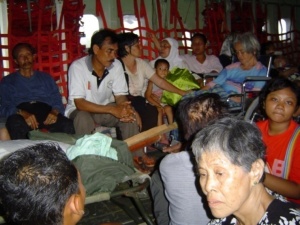 Tsunami refugees from Aceh evacuated
to Medan
Tsunami refugees from Aceh evacuated
to Medan
It is clear that victims and casualties are unavoidable during warfare or even low level conflicts. Casualties are entitled to the best quality of treatment; however, care facilities on the front lines are generally very limited. Casualties need to be immediately evacuated to a higher-level hospital in the rear. One of the best ways to effect rapid and relatively safe evacuation is to use air transportation, also known as aeromedical evacuation (AME). The transport of seriously ill or injured patients to medical facilities was pioneered and to a large extent perfected by military forces. From the “flying ambulances” of Napoleonic times to modern jet aircraft with flying intensive care wards, a major part of our experience with the transport of patients over the years derives from military medical care.
Medical evacuation, often termed MEDEVAC or Medevac, involves the timely and efficient movement of casualties and the provision of en route medical care to the wounded being evacuated to receiving medical facilities using medically equipped ground vehicles (ambulances) or aircraft (air ambulances). In modern American military terminology, Medevac is often differentiated from Casualty Evacuation (Casevac). In this context, Casevac refers to the moving of a patient either from the point of injury or a casualty collection point to a medical facility or between the different levels of care with en route medical care. Medevac, on the other hand, involves limited or no en route care and medical equipment. Casevac is heavily utilised by the US Marine Corps and manned by US Navy Hospital Corpsman; its helicopters are combat aircraft and will, as needed, land in 'hot zones', whereas Medevac helicopters do not due to the risk of exposure to hostile fire.
The term AirMedEvac or AME is commonly applied when a fixed-wing aircraft or helicopter is used as an ambulance (sometimes called an "air ambulance") that can supply medical care en route. This ensures the rapid transport of seriously injured persons, particularly trauma patients, from the scene of the accident to the hospital. The term Medevac is usually used for the evacuation of patients from lower to higher level medical facilities. There are land Medevac, sea Medevac and air Medevac (AME) (or Pengungsian Medik Udara (PMU)). Our Indonesian Air Force SOP (Standard Operating Procedure) defines AirMedEvac/AME as the transfer of patients from a particular medical facility to a higher-level medical facility by means of air transportation in the presence of medical attendants. Casevac, according to the UN medical SOP, involves the evacuation of victims from the point of injury, or a casualty collection point, to a medical facility; we usually use helicopters for this and employ the term Air Casevac.
The history of Aeromedical Evacuation
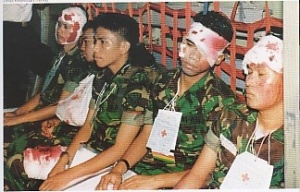 AME training
AME training
The experience of American military forces over the last century illustrates the efficacy of early rescue and rapid transport of the patient to a facility for stabilisation. The mortality rate of patients evacuated from the battlefield to a medical facility was reduced from 8.1% in World War I to 2.5% in Vietnam, and the casualty fatality rate of 27% in World War II was reduced to 17% in Vietnam. Survival is dependent on early identification of the victim, the provision of life-saving care at the scene, and rapid transport of the victim to a hospital for stabilisation.
In the Vietnam War, almost all (over 90%) of medical evacuation was undertaken by air. From the site of wounding, patients were taken by any means possible to the helicopter landing site, from which they were usually taken directly by helicopter to a hospital. This is known as forward Medevac. The other types are tactical and strategic Medevac. During Operation Desert Shield, 242 C-130 aeromedical evacuation missions were flown, transporting 2,136 patients. A total of 173 C-130 missions were flown during Operation Desert Storm, which transported 2,375 patients, including Coalition and Iraqi casualties.
Experiences of the Indonesian Armed Forces/Tentara NasionalIndonesia (TNI)
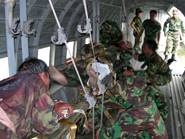 AME in a Dakota
AME in a Dakota
The TNI have experience of conducting AME, both tactical and strategic. In addition to military AME, the TNI, using many kinds of different aircraft, also provide and support AME for civilians should disaster strike any of the many islands making up Indonesia. During the Trikora Operation in 1960, the TNI used six C-47 Dakotas as air ambulances based in Mandai AFB, Makasar. In East Timor, during the Seroja Operation, Puma, Super Puma, Super Frelon, Bolkow, Iroquois and Hughes helicopters were employed for tactical Medevac to evacuate casualties to Penfui AFB in Kupang. The TNI also employs fixed wing aircraft, such the CASA, Dakota and Albatross. During tactical AME from battlefield to Dili, 473 casualties were evacuated in 1975 – 1976. In 1977, 1,717 victims were evacuated; the outcome was fatal in 199 of these cases. A total of 2,096 victims were evacuated in 1978 (276 fatalities) and 1,155 were evacuated in 1979 (59 fatalities). During strategic Aero Medevac operations in 1975 – 1979, 3,776 casualties were transported from Dili to the Naval Hospital in Surabaya and the Army Central Hospital in Jakarta. Hercules aircraft were used for 158 missions, F-27s for 44 missions and a C-47 Dakota for one mission.
The organisation of Aero Medevac
 AME II
AME II
Aeromedical Evacuation (AME) needs to be well organised if it is to function efficiently. All treatments provided by the referring facility, during the trip and until confirmation of receipt by the destination hospital must be carefully documented. In the case of the TNI AU (Indonesian Air Force), the Chief of the Health Service is responsible for the coordination of AME operations. He instructs the Chief of the Aeromedical Service to plan an AME, and the Chief of the Health Service of I/II TNI AU Operation Command will coordinate the AME technical aspects with the AME teams.
The AME force consists of medical teams I, II and III. The AME I team, led by a flight surgeon at the departure airbase, is responsible for triage (medical clearance), the preparation of all medical documentation, food, security, providing for the physical and psychological wellbeing of the patients, and assisting the AME II team to transfer patients to the aircraft. The AME II team is led by a flight surgeon or senior flight nurse and is responsible for the patient after the hand- over by the AME I team, during the flight and until the patient is unloaded at the destination air base. They must be present at the pre-flight briefing and report to the captain in command of the aircraft. The AME III team at the destination air base is led by a flight surgeon or the Chief of TNI AU Medical Service at the destination airbase. They are provided with support by medical personnel of military or civilian medical services who provide ambulances to transport patients to the destination hospital. AME operations involve personnel, medical logistics and medical administration, and it is ensured that all these are carefully coordinated. The personnel consists of AME teams I, II and III. Medical logistical support is provided in the form of a flight nurse kit, a flight surgeon kit, an air ambulance kit and ambulance kit, while there is management of patient data before, during and after the flight.
The aircraft
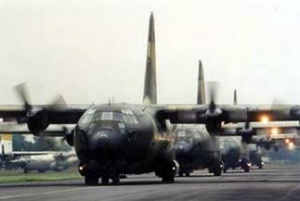 C-130s being used for strategic
AirMedEvac
C-130s being used for strategic
AirMedEvac
There are several types of aircraft which are used in AME: pressurised and non-pressurised cabin fixed wing aircraft and rotary wing aircraft – both military and civilian aircraft can be employed. The working area inside most aircraft is much smaller than in a hospital setting. The low cabin height reduces the gravity feed of IV lines. The limited dimensions make the handling of large stretcher patients or those with splints more difficult.
The restricted cabin dimensions mean there are limitations with regard to patient positioning and that the space available for setting up and for resuscitation is minimal. Mobile environments are subject to sudden movements, which can lead to damage or even injury. Equipment must be kept secured but must still be readily accessible for medical personnel. Equipment needs to be portable and must have a power supply that is independent of the aircraft power supply. The maximum take-off weight and centre of gravity must be considered when loading patients. This may limit the number of patients who can be carried and involve restrictions with regard to their relative positioning in the aircraft. High temperatures, short airstrips and the requirement to take additional fuel for long distance flights or due to weather can further reduce the payload. Communications are impaired in the noisy environment. Procedures are more difficult and concentration is affected due to the temperature and humidity. Adequate illumination is required for observation and procedures. The use of hazardous and corrosive items such as mercurial thermometers, batteries, oxygen, must be restricted and the spillage of certain body fluids (cerebrospinal fluid, urine and blood) must be avoided since these can cause damage to the aircraft. Personnel need to regularly practice safety drills since most patients pose problems for rapid evacuation. Flight protocols will also need to be observed during various phases of the trip. Medical personnel also need to be aware of and practice the rules and regulations related to aircraft operations.
The medical equipment
Listed in the following is the essential equipment required for the transportation of patients by air. All personnel need to be familiar with the use of these items:
- Resuscitation set + oxygen
- Ambu bag
- Intubation set
- Suction apparatus
- Sphygmomanometer
- Infusion & infusion set
- IV catheter & CVP Set
- Dressings
- Fixation tools & splints
- Vacuum mattress
- Injection set
- Minor surgery set
- Gastric tubes
- Portable ECG & defibrillator
Drugs and consumables need to be stored in compact containers. Essential medical equipment has to be kept secured but still within reach. Every crew member must know exactly what is on board and where it is, so that they not dependent on other crew members in an emergency.
TNI AU Air Medical Container
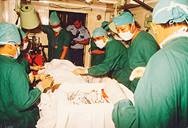 Surgery
being
performed
in the
AMC
Surgery
being
performed
in the
AMC
The Air Medical Container (AMC) is one of the amenities provided by the TNI AU Health Service. The AMC provides a high tech environment in which highly skilled personnel can work during an AME mission. Within our AMC, we maintain “ground level conditions”, in other words, the pressure maintained inside the container is almost identical to that at ground level, even though the container itself may be, at any one time, being transported at an altitude of 20,000 feet. The AMC is compatible with the Hercules C-130 H. It has its own power generator and x-ray unit. The AMC can function as an ICU or operation room. It is designated as an airborne ICU by the TNI AU.
The AMC of the TNI AU has been in use for more than 20 years and we have already gained considerable experience with it. It is used during every important visit of the Indonesian President, has provided an emergency back-up during the ASEAN meeting in the Philippines in the late 1980s and has been used for the transport of severe ill or injured service personnel in more recent times.
The AMC team consists of doctors, highly skilled nursing staff, and an equipment expert. Certain specialists, such as intensive care physicians, cardiologists, surgeons and internists may also be on board depending on the situation. The nursing personnel are one intensive care assistant, one OR nurse and one circulating nurse. The equipment expert is responsible for liaising with the aircrew and for the maintenance of the AMC and other medical equipment. A specialist may be appointed as head of the AMC team depending on the purpose of the mission.
The average time for transporting the AMC from its hospital base (e.g. TNI AU Central Hospital) to the nearest air force base (e.g. Halim Air Force Base), including the time required to prepare equipment, takesapproximately 2 hours. Some 1 -5 hours are required for the C-130 to arrive at the destination air force base (Jakarta to Yogjakarta is less than 1 hour, but Jakarta to Papua is more than 4 hours). That means that up to 6 hours will elapse from the point of time that the service was requested until the AMC is delivered to the destination air force base. Taking into account all aspects of decision-making, coordination etc, the turn-around time for a mission is generally less than 24 hours.
Physiological considerations
Aeromedical transport exposes patients and their medical attendants to an altered physical environment, as well as an altered working environment. The former will have significant physiological effects on both patients and crew whilst the latter may restrict the on-going management of the patients' clinical problems. Altitude hypoxia can occur when arterial pO2 is reduced from about 100 mmHg at sea level to around 60 mmHg at 10,000 ft. There is the risk of conditions caused by dysbarism because gases will expand at the low pressures occurring at high altitudes. Vibration and turbulence induced by engines and the aerodynamics of the airframe can interfere with the functioning of the equipment, can exacerbate the condition of the patients, and even impair the concentration of the medical personnel. Noise will affect communication and auscultation. Patients and crews are exposed to a broad range of temperatures and are thus subject to thermal stress. Because the aircraft accelerates and decelerates during take-off and landing, vestibular disturbances can cause motion sickness in patients and crew.
Tactical Aeromedical Evacuation
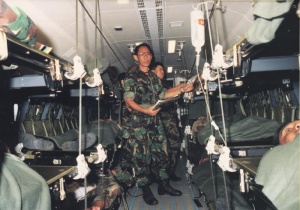 Inside a CN-235
Inside a CN-235
The medical officers of the referring medical facilities or hospitals must conduct triage carefully and prepare patients thoroughly to ensure they survive air transportation. They must be capable of identifying high risk conditions that represent contraindications for air transport, and must proactively intervene to ensure that these patients can survive. Tactical AME involves the transfer of surgical patients to higher level and more secure hospitals and is undertaken by AME team I. Patients are assessed on the basis of indications and contraindications. Light or medium-light aircraft are usually used for transport. There are certain contraindications to tactical AME: casualties in critical status, infectious illnesses requiring quarantine, tuberculosis (depending on stage), shock, severe anaemia (HB <10%), acute ischemic cardiac diseases, acute myocardial infarction, uncontrolled epilepsy, aggressive mental illness, pulmonary diseases with respiratory dysfunction, pregnancy > 32 weeks and infants < 10 days old.
Strategic Aeromedical Evacuation
Strategic AME is performed to get casualties out of operating theatres. One of its purposes is to decrease AFB workload at the surgical stage. After careful triage, conly those patients who genuinely require further medical treatment are evacuated; contraindications to strategic AME are: terminally ill patients who do not have a condition amenable to medical intervention, “no code” patients, “do not resuscitate” patients and those with complete circulatory arrest at the referring facility that cannot be stabilised by means of perfusion prior to transport. For those patients selected for strategic AME, the status is revised from combat personnel to non-combat personnel. Large transport aircraft are usually used for strategic AMC.
Conclusions
Aeromedical evacuation (AME) is a rapid and relatively safe method for the evacuation of patients by means of air transportation. There are several limitations to AME due to the influence of the environmenton the human physiology. However, AME can be highly efficient if it is appropriately organised.
Date: 08/22/2018
Source: Medical Corps International Forum 2/2011











